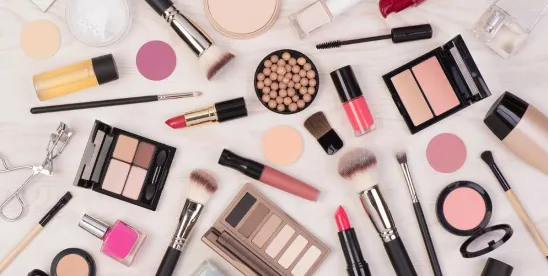Cosmetics, including skin moisturizers, makeup, nail polish, shampoos, hair color, and deodorants, are predominantly regulated by the Food and Drug Administration (FDA).[1] For those in the cosmetics industry, the Consumer Products Safety Commission (CPSC or Commission) may be of little concern. However, social media is potentially altering the regulatory landscape. Specifically, as cosmetics companies partner with social media “beauty influencers” to market their products, they are arguably advertising to increasingly younger consumers, including children and “tweens”—groups that are a main focus of CPSC regulation. This marketing strategy gives rise to potential new issues and questions, including whether products could be considered “children’s products” subject to further regulation and heightened scrutiny from the Commission.
As of now, the CPSC regulates a few areas relevant to the cosmetics industry. For example, the CPSC maintains jurisdiction over child-resistant packaging requirements under the Poison Prevention Packaging Act (PPPA). Thus, if certain cosmetics products contain any hazardous substances, those products must comply with the PPPA and are subject to oversight from the CPSC. The CSPC also maintains jurisdiction over other product packaging issues and products relevant to the larger beauty industry (e.g., a hair drier that poses a shock hazard to consumers). As cosmetics companies target younger audiences and expand their offerings beyond products meant just for adults, this may open them up to greater compliance duties to, and regulatory oversight from, the CPSC.
Who Regulates Cosmetics?
The Federal Food, Drug, and Cosmetic Act (the FD&C Act) grants the FDA nearly exclusive authority over the cosmetic industry. It defines cosmetics as “articles … applied to the human body … for cleansing, beautifying, promoting attractiveness, or altering the appearance.”[2] The Modernization of Cosmetics Regulation Act of 2022 added the definition for “cosmetic product” to the FD&C Act, which is defined as “a preparation of cosmetic ingredients with a qualitatively and quantitatively set composition for use in a finished product.”[3] Thus, the FDA promulgates safety guidelines for nearly all aspects of cleansers, makeup, nail polishes, lotions, deodorants, and more. However, as detailed below, the CPSC regulates a few areas relevant to the cosmetics industry.
The Poison Prevention Packaging Act
The PPPA, enacted in 1970, aims to prevent children from accessing and ingesting hazardous or toxic substances used in common household products, including cosmetics. It requires these products be sold in “special packaging,” which is defined as packaging that is “significantly difficult for children under 5 years of age to open…”[4] These “toxic” or “harmful” household substances are defined under Section 2(f) of the Federal Hazardous Substance Act (FHSA) and Section 201 of the FD&C Act. The PPPA likewise provides for specific substances that must be contained in Special Packaging based on its concentration, medium of preparation, and other environmental factors.[5]
Companies that fail to meet these standards face the risk of a potential CPSC recall. For example, a luxury cosmetics company recently recalled a bathroom deodorizing essential oil blend because it contained low-viscosity hydrocarbons, but did not comply with the PPPA’s packaging requirements. In the recall press release, the CPSC noted that the product posed a poison risk to children and additionally omitted mandatory information on the packaging under the FHSA.
Other Potential Hazards in the Beauty Industry
In addition to the child-safe packaging discussed above, the CPSC has recalled several cosmetic products for defects in the packaging that create hazards or pose serious injury risk to consumers. Such recalls include over 200,000 units of a Peptide-C cream due to concerns that the packaging would break open over time and cause laceration hazards, roughly 1,000,000 cans of a spray mousse due to similar degradation concerns, and the recall of a small lip gloss key chain because the clasp contained high levels of lead.
Most beauty industry products recalled by the CPSC, however, are those that pose electrical shock and fire hazards. These include blow driers, hair curlers, and even a roll-on waxing kit. Though these products do not qualify as “cosmetics,” they may nevertheless be manufactured and sold by cosmetics companies.
The Impact of Beauty Influencing
The CPSC has not signaled any immediate interest in revisiting regulations that directly impact cosmetics. However, it is no secret that child-safety standards are a major priority for the agency. The rise of TikTok, YouTube, and “beauty influencers” has prompted increasingly younger consumers to buy and use makeup and skincare products. As aptly stated by beauty magazine, Allure: “The tweens have taken over.”[6] Kids and tweens between the ages of 6-13 are now racing to purchase products with young, fun, vibrant packaging that contain anti-aging ingredients like retinol and hyaluronic acid—to the concern of many parents.
While there have always been play makeup kits for kids that are regulated as toys, social media has seemingly created a new issue: Kids and tweens are now interested in cosmetics and other beauty products that seem to have been originally intended for adults. Given the agency’s long-standing focus on children’s products, this trend may draw the attention of the CPSC.
The CPSC defines “Children’s Product” as any product intended for a 12-year-old or younger. In making its assessment as to whether a product fits this definition, the CPSC considers the product’s intended use and whether it is marketed to children. In combination with current trends, this definition could result in several new issues for cosmetics companies. For example, cosmetics companies partnering with social media influencers whose following includes children under 12 could be seen as marketing their products to children.
Key Takeaway
Regulation of cosmetics is rife with nuance. Technical knowledge of product formulas, packaging issues, and corresponding regulations is essential.
[1] 15 U.S.C. § 2052(a)(5)(H) expressly exempts “drugs, devices, or cosmetics,” from the definition of a “Consumer Product” under the Consumer Product Safety Act.
[2] 21 U.S.C. § 321(i).
[3] 21 U.S.C. § 364(2).
[6] Kara Nesvig, A Sephora Employee Confirms the Tween Takeover is Real, Allure (Jan. 12, 2024), https://www.allure.com/story/tweens-shopping-at-sephora-stores-tiktok.






 />i
/>i

